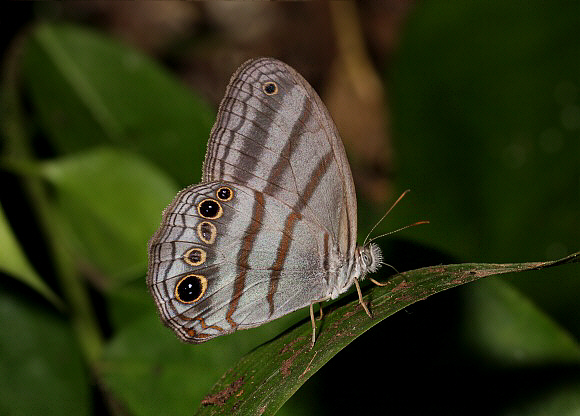
Introduction
There are 1100 known species of Satyrinae in the neotropical region. About 400 of these are placed in the Euptychiina. Butterflies within this tribe include the “ringlet” genera Euptychia, Magneuptychia, Harjesia, Cissia, Caeruleuptychia, Magneuptychia, Harjesia etc; together with Oressinoma and the various “wood nymph” genera i.e. Parataygetis, Posttaygetis and Taygetis. Most are inhabitants of the forest understorey and tend to fly close to the ground. They generally avoid sunlight and prefer to fly at dawn or on cloudy days when light levels and temperatures are low.
Until fairly recently almost all of the “ringlets” were placed in the genus Euptychia, but revisions by Forster and Lamas divide this convenience genus into a number of smaller genera, on the basis of anatomical differences and larval foodplants.
There are 40 known species in the genus Magneuptychia including 11 recently described by Lamas but as yet unnamed. The butterflies are slightly larger than most other ringlets and typically have a grey ground colour overlaid with a bluish sheen. The bands on the underside are always narrow, well defined and reddish in colour. The ocelli on the hindwings are prominent and the 2 largest ones each contain a pair of tiny white dots.
Magneuptychia ocnus is distributed throughout the Amazonian region.
Habitats
The butterfly occurs in tropical rainforest at elevations between 0-1500m.
Lifecycle
I have no data relating to the lifecycle of ocnus. The lifecycle is likely to be very similar to that of libye as follows: The egg is round and laid singly on or near the foodplants. The larva when fully grown is pale brown with darker and paler lines and striations along the back and sides. The head bears a pair of short conical horns. It feeds nocturnally on the grass Panicum ( Poaceae ) and rests during daylight at the base of the plant. The chrysalis is back with a hint of pink along the abdomen.
Adult behaviour
The butterflies inhabit the understorey, and are usually only seen along the darker and narrower trails. They don’t visit flowers but feed instead at decomposing fungi and bird droppings. Most of the time they sit motionless on leaves in the shade, and if disturbed they generally fly a distance of no more than 3 or 4 metres, and then re-settle.
It is likely that the wings reflect high levels of ultra-violet, enabling the butterflies to locate potential mates visually in the dark environment where they breed. The vertical lines on the underside are an example of disruptive colouration. They help break up the outline of the wings into separate shapes, making it more difficult for a bird to detect the butterfly. If however a bird succeeds in discovering where it has settled, the butterfly has a secondary defence in the form of the ocelli on the underside hindwings. These function to divert attacks away from the butterfly’s vulnerable body, allowing it to escape with nothing worse than a pecked wing.
